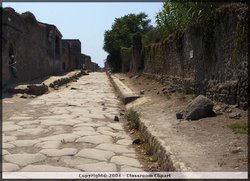Roman road
|
|

The Romans, for military, commercial and political reasons, became adept at constructing roads. Many long sections of them are ruler-straight, but it should not be thought that all of them were. The Roman roads were essential for the growth of their empire, by enabling them to move armies speedily and by sustaining land transport for Roman mercantilism. The Roman emphasis on constructing straight roads often resulted in steep grades relatively impractical for most economic traffic: over the years the Romans themselves realized it and built longer, but more manageable, alternatives to existing roads. These long highways were very important in maintaining both the stability and expansion of the empire; but in late Antiquity, the same roads, by offering avenues of invasion to the barbarians, contributed to Roman military reverses.
The Roman roads vary from simple corduroy roads to using deep roadbeds of crushed stone as an underlying layer to ensure that they kept dry, as the water would flow out from the crushed stone, instead of becoming mud in clay soils. The legions made good time on these roads, and some are still used millennia later.
A proverb says that "all roads lead to Rome". Roman roads were designed that way to hinder provinces organising resistance against the Empire. At its peak, the Roman road system spanned 50,000 miles.
| Contents |
Some Roman roads
There are many examples of roads that still follow the route of Roman roads.
Albania / Greece / Turkey
- Via Egnatia (146 BC) connecting Dyrrhachium to Byzantium via Thessaloniki
France
- Via Aquitania, from Narbonne, where it connected to the Via Domitia, to the Atlantic Ocean across Toulouse and Bordeaux,
- Via Domitia (118 BC), from Nimes to the Pyrenees, where it joins to the Via Augusta at the Col de Panissars.
Italy
major roads
- Via Aemilia, from Ariminum to Piacenza
- Via Appia, the Appian way (312 BC), from Rome to Apulia (Puglia)
- Via Aurelia (241 BC), from Rome to France
- Via Cassia, from Rome to Tuscany
- Via Flaminia, from Rome to Ariminum
- Via Salaria, from Rome to the Adriatic Sea (in the Marches)
others
- Via Aemilia Scaura (109 BC),
- Via Amerina, from Rome to Ameria and Perusia
- Via Claudia Julia Augusta (13 BC)
- Via Clodia, from Rome to Tuscany forming a system with the Cassia
- Via Julia Augusta (8 BC),
- Via Labicana, southeast from Rome, forming a system with the Praenestina
- Via Ostiense, from Rome to Ostia
- Via Postumia (148),
- Via Praenestina, from Rome to Praeneste
- the name of most of these roads is derived from the censor who ordered their construction
Trans-Alpine Roads
These roads connected modern Italy and Germany
- Via Claudia Augusta from Venice to Augsburg via the Reschen Pass
- Via Mala from Milan to Lindau via the San Bernardino Pass
Spain
- Iter ab Emerita Asturicam, from Sevilla to [[Gij. Now is the A-66 freeway.
- Via Augusta, from Cᤩz to the Pyrenees, where it joins to the Via Domitia at the Coll de Panissars, near La Jonquera. It passes through Valencia, Tarragona and Barcelona.
United Kingdom
For main article see Roman roads in Britain
